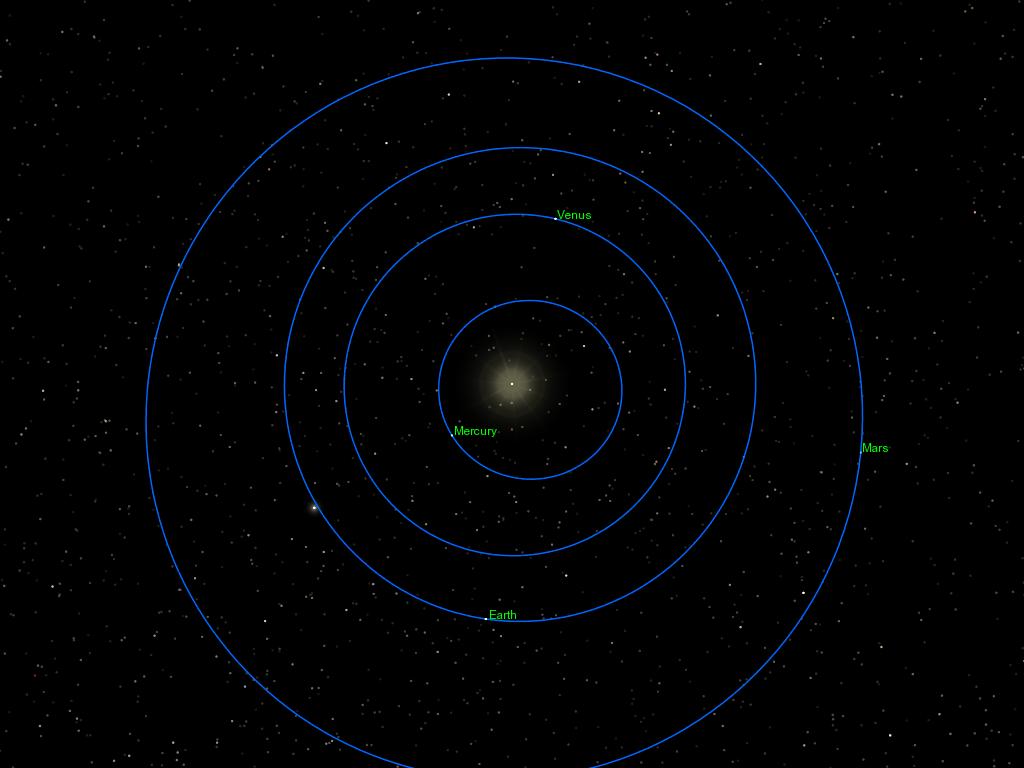
 Copyright © Michael Richmond.
This work is licensed under a Creative Commons License.
Copyright © Michael Richmond.
This work is licensed under a Creative Commons License.
Today we look at the second major group of large bodies in our Solar System: the gas giants. We'll take them in the usual order, following their distance from the Sun.
The first thing about the gas giants is that they live far, far from the Sun.

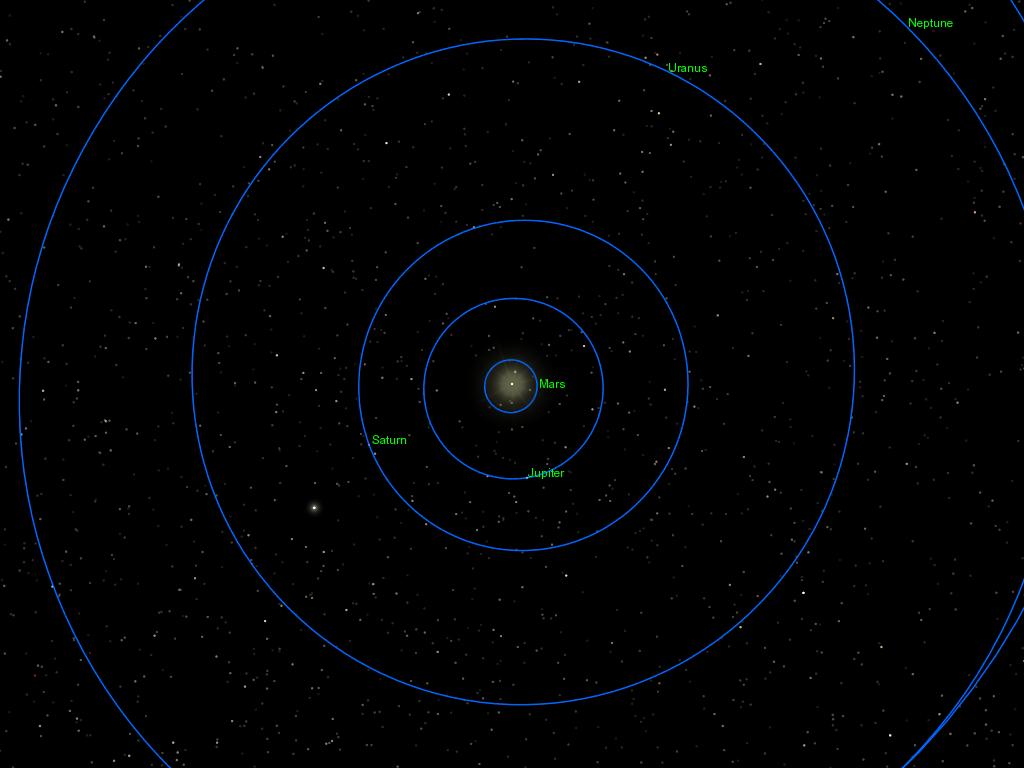
As a result, during the formation of the Solar System, these planets retained most of the gas and volatiles which comprised the majority of the proto-solar nebula. They all have very, very extended, thick atmospheres, dominated by hydrogen and its compounds.
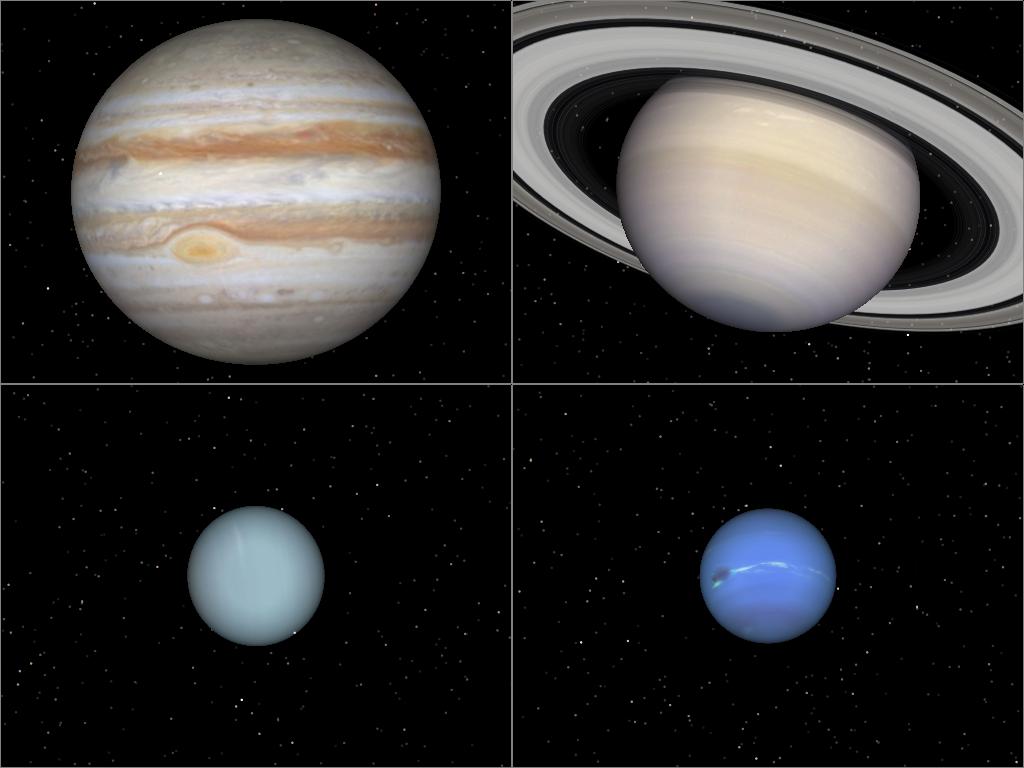
As a result, they are much more massive and larger than the terrestial bodies.
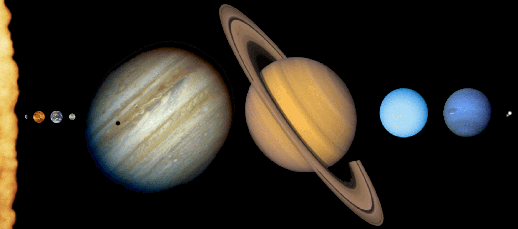
On the other hand, since they are mostly gaseous, their densities are quite a bit lower than those of the terrestrial bodies.
planet radius mass
(km) (kg)
--------------------------------------------
Jupiter 71,494 1.90 x 10^(27)
Saturn 60,330 5.69 x 10^(26)
Uranus 25,559 8.69 x 10^(25)
Neptune 24,750 1.03 x 10^(26)
---------------------------------------------
Q: Which of the gas giants would float if you
could find a bathtub big enough to hold it?
Jupiter is by far the most massive of the planets. It is more than twice as massive as all the other planets put together; even so, it is only about 1/1000 the mass of the Sun.
The most prominent features of Jupiter in the visible are the patterns in its clouds. We call the dark ones belts and the bright ones zones.
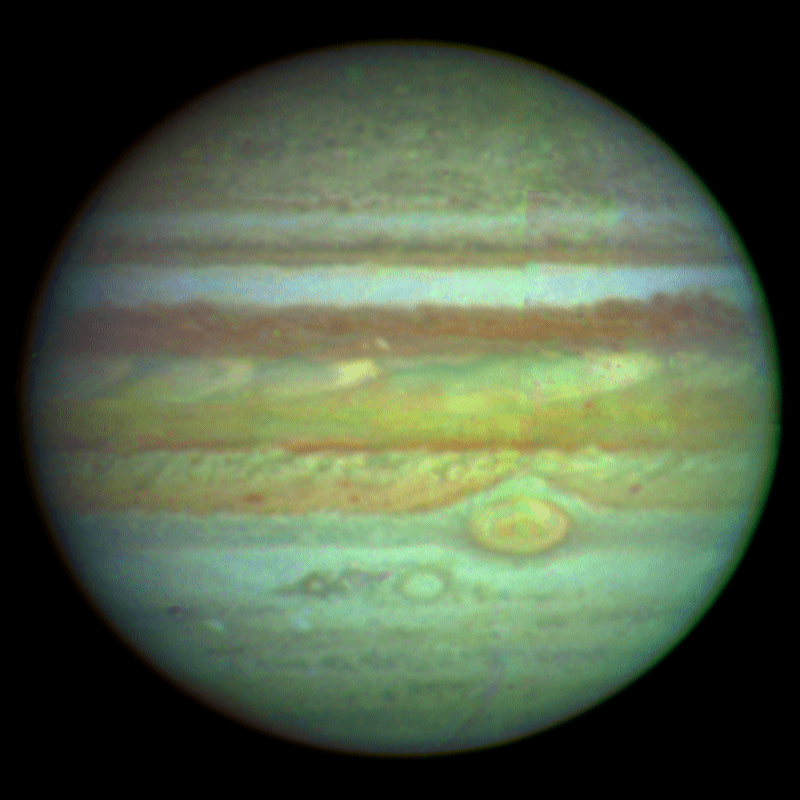
An infrared picture of Jupiter (on the left below) shows variations in the temperature of its atmosphere: bright areas are warm and dark areas are cold. If we compare the view of Jupiter in the infrared to the visible, we see that the belts are warmer than the zones. We believe that heat from the interior of the planet warms gas, which rises up in the belts, cools off, then falls back down through the zones to the interior again.
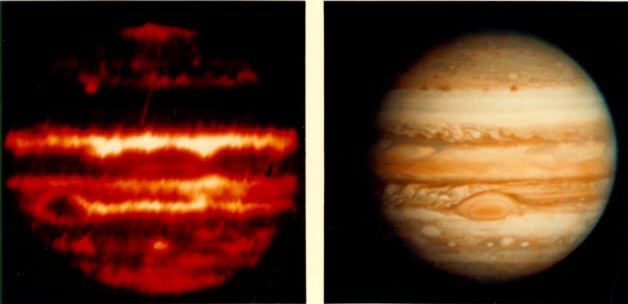
Scientists are still trying to understand the "weather" on Jupiter. On Earth, the energy which drives winds and fronts comes from the outside -- from the Sun. But on Jupiter, it appears that the dominant force of energy input to the atmosphere comes from the inside -- from residual heat left over from the planet's formation, four and a half billion years ago, which is slowly leaking outwards.
The gas in adjacent zones and belts moves at slightly different speeds, causing all sorts of interesting eddies and vortices at their interfaces.
The largest of these is a gigantic cyclonic storm called The Great Red Spot, which has been visible in the planet's atmosphere for over three hundred years. You can't tell in this monochrome image taken by the Galileo spacecraft,
but it really does look red; a rather pastel shade, more like salmon than fire-engine red.
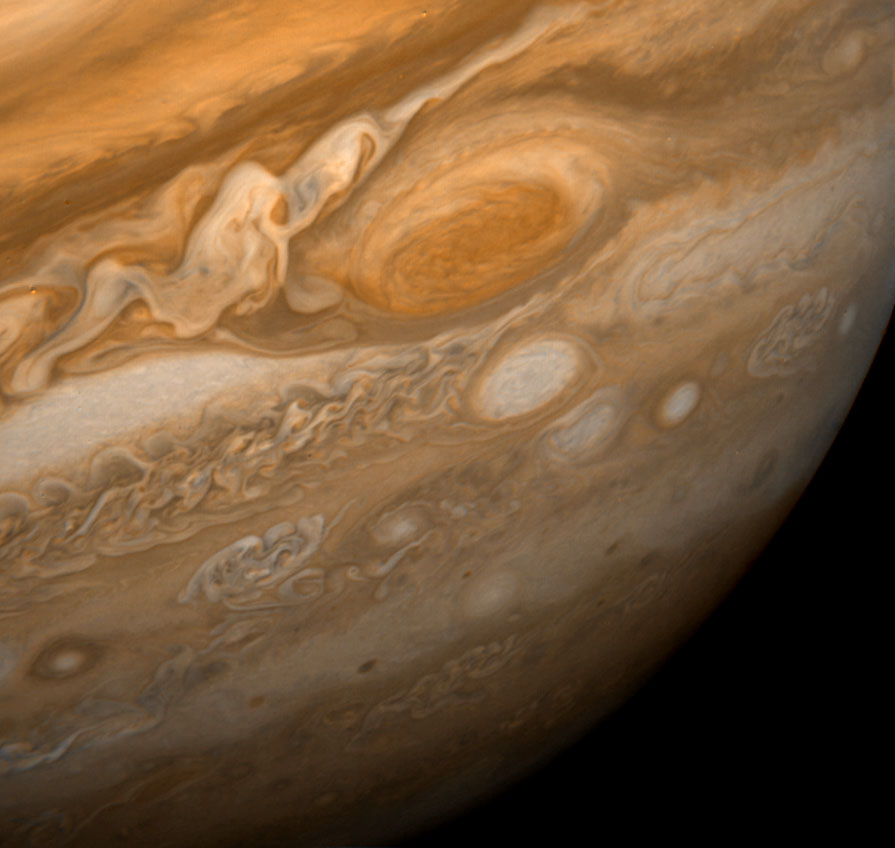
I mentioned in yesterday's lecture that Jupiter has a very strong magnetic field. The magnetic field traps charged particles and forces them towards the magnetic poles of the planet. When they strike the atmosphere near the poles, they create aurorae -- just like the ones on Earth. The glow produced by the collision of charged particles with the atmosphere is best seen in the ultraviolet, as these HST images show.
Saturn is perhaps the prettiest planet of all, thanks to its rings (though we will see later that it is not the ONLY planet with rings...)
Its cloudtops seem rather bland compared to the colorful patterns one can see on Jupiter.
If you take pictures through a set of different filters and then push the contrast, you can see that Saturn does still have atmospheric bands somewhat like those of Jupiter.
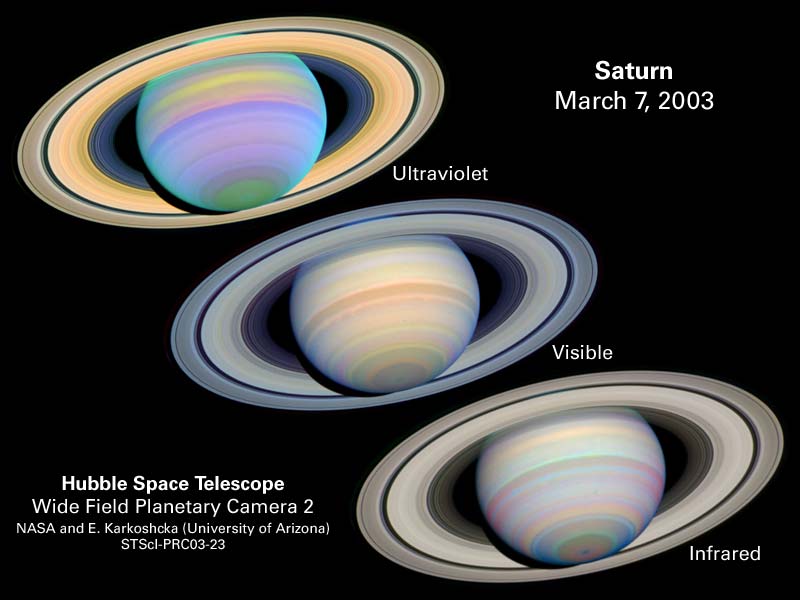 They are much weaker, though,
for several reasons:
They are much weaker, though,
for several reasons:
Like Jupiter and the Earth, Saturn has a magnetic field strong enough to cause aurorae near its poles:
At first glance, the planet Uranus may appear, well, boring:
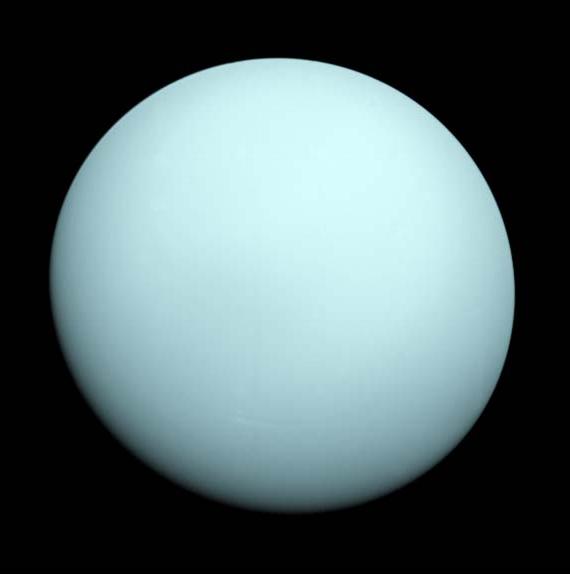
But Uranus does have its intriguing aspects. For example, if you examine the motions of its moons, and increase the contrast in images of the planet itself, you find that it seems to be "lying on its side":
Uranus' axis of rotation is not perpendicular to the plane of its orbit, like all the other planets; instead, the axis of rotation lies almost exactly in the plane of the orbit.
We are pretty sure that when Uranus was forming in the proto-solar nebula, it originally spun in the usual way, with an axis perpendicular to the plane of the orbit. How did Uranus end up this way? We don't know. One explanation is that several planet-sized bodies formed from the material in the proto-planetary disk at the rough location of Uranus, then merged to form the current planet. If one of the last collisions occured off-center, it might have tipped the axis of rotation in a major way (but that collision didn't happen recently ).
The temperature of Uranus' cloudtops -- about -200 Celsius -- is even colder than that of Saturn's upper layers, which are a relatively balmy -180 Celsius. As a result, an even thicker methane haze covers the planet, hiding details of the atmosphere. Taking pictures in the near-infrared, like this one with the HST NICMOS instrument, does reveal some belts and a few cloud features.
In many ways, Neptune is a twin of Uranus.
Its big, blue atmosphere (from which its name derives) seems at first glance relatively featureless. The blue color is due to the very thick methane haze in the upper atmosphere: it absorbs long wavelengths of light more strongly than short ones, so that the little light reflected from the planet is mostly blue.
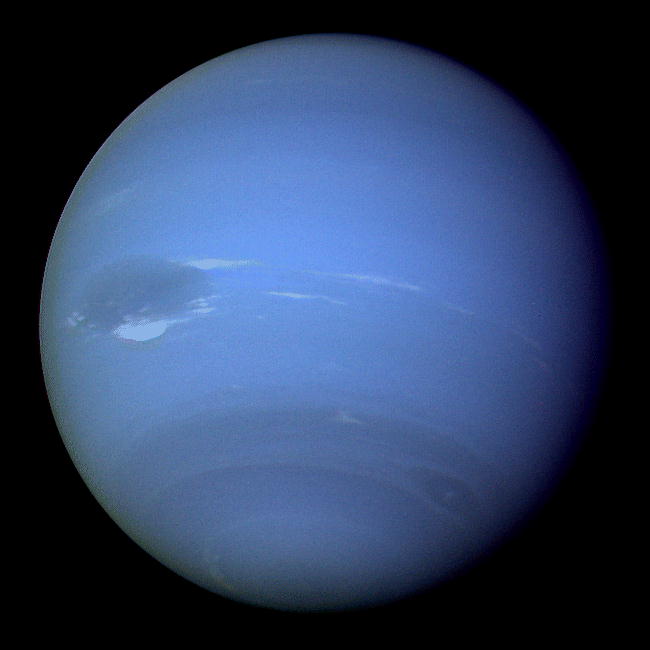
However, one can use filters and a bit of image processing to enhance the faint features. These images taken by HST show a gradual increase in atmospheric activity as Neptune's southern hemisphere slowly tilts towards the Sun.
When the Voyager 2 spacecraft zipped past Neptune in 1989, it discovered a large cyclonic storm system reminiscent of the Great Red Spot on Jupiter. Scientists call this the "Great Dark Spot."
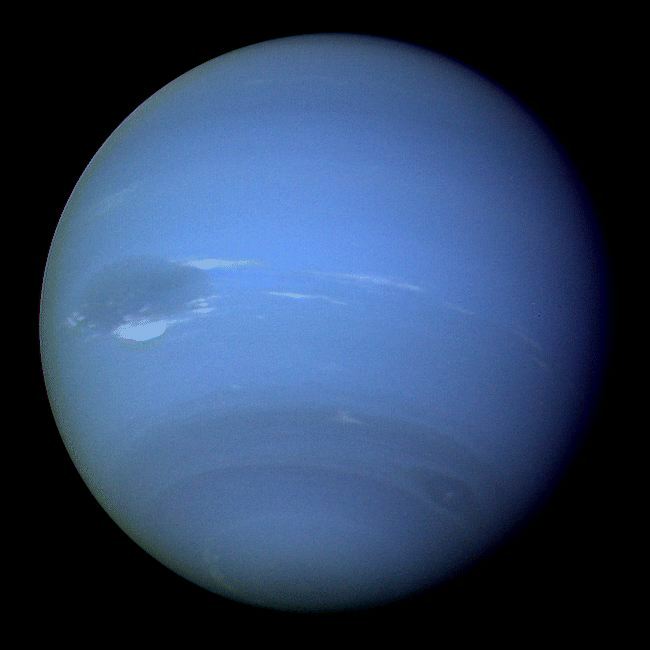
There are also less dramatic clouds scattered across the disk of Neptune:
You all know that Saturn is surrounded by rings ... but did you know that it is not the only one? In fact, ALL the gas giants have rings systems of some sort.
The rings around Jupiter were first detected in this image taken by the Voyager 1 spacecraft in 1979. The exposure time was very long -- over 11 minutes! -- in order to search for very faint ring features. Due to the motion of the spacecraft during the exposures, stars in the background appear to be jiggly trails.
Later images taken by Voyager 2 and (as below) Galileo show more detail.
The rings of Uranus were discovered by accident in 1977, as astronomers interested in the ATMOSPHERE of the planet prepared to watch Uranus pass in front of a star.
As this Voyager image shows, the Uranian rings are narrow and sparse compared to Saturn's rings.
There was some evidence from stellar occultations in the 1980s that Neptune might also have rings, but it seemed a bit flakey: sometimes a star would blink out for a moment as if there were a ring on one side of the planet, but then it might not blink out again as it passed behind the other side of the planet. Huh?
It wasn't until the Voyager 2 spacecraft visited Neptune in 1989 that the rings were confirmed beyond a doubt. As you can see, they are very skimpy.
It turns out that some of the rings around Neptune are incomplete: they are really arcs, not rings. That is why some of the occulation data didn't look right.
We'll look at the dynamics of rings, and at their origin, in a future lecture.
 Copyright © Michael Richmond.
This work is licensed under a Creative Commons License.
Copyright © Michael Richmond.
This work is licensed under a Creative Commons License.